The interministerial economic
planning committee (CIPE) on Wednesday approved a Grand Project
for Ostia Antica along the lines of the one that has enhanced
visits to Pompeii.
The CIPE earmarked some 40 million euros to valorise and
reopen some areas of the ancient Roman port as well as setting
up a new unified visit system linking up the archaeological site
of Portus and highlighting the landscape of the area, sources
said.
The project will also set up a university campus offering a
new degree course by the Roma Tre University, also linked to
Ostia's university annex.
In 2014 Rome's archaeological superintendecy announced new
findings at Ostia, saying the "secret" site was bigger than
Pompeii.
The "exceptional results" revealed that Rome was "split in
two by the Tiber River in the First Century BC," it said.
The find was enormous, including towers and warehouses as
well as boundary walls that scholars say had been missing from
what had been previously recovered from the popular site located
on the southwestern edge of Rome.
Experts from Italy and Britain were involved in the
discovery, using special equipment to identify buried ancient
walls, road layouts and structures buried beneath the earth.
The finding shed new light on how important Ostia was to
trade in the first 200 years of the first millennium, said
Mariarosaria Barbera, superintendent of Rome's archaeological
heritage.
Ancient Roman Ostia, at the since-moved mouth of the River
Tiber, was built into a massive complex under the Emperor
Claudius and given the name Portus, meaning port.
It was expanded under successive emperors such as Trajan
and Hadrian and served as a base for many of the empire's
greatest expeditions.
Ostia was also the depot channelling the vast wealth, grain
and other supplies needed to feed the appetites of the imperial
city.
ALL RIGHTS RESERVED © Copyright ANSA











